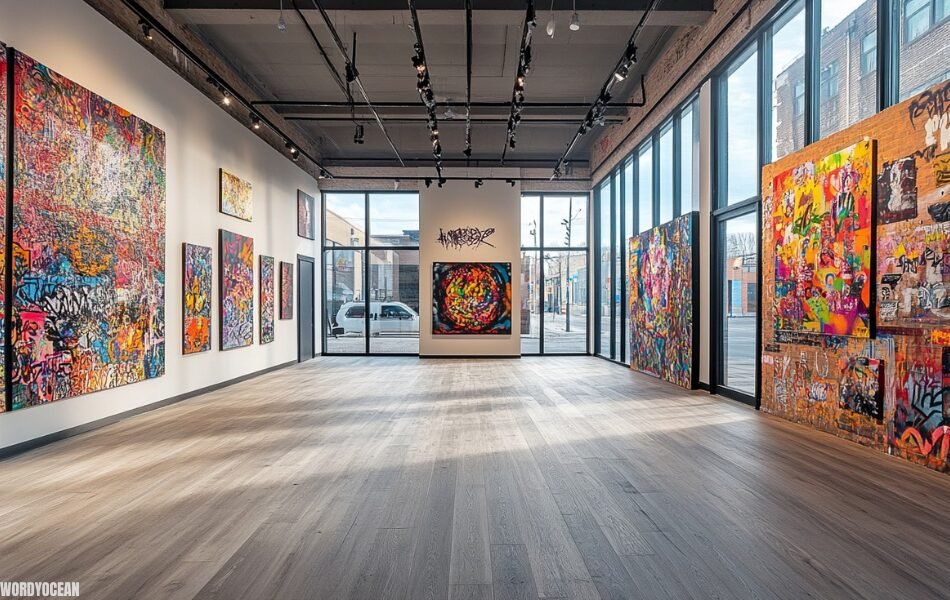Patausche Kivua Art: Discover the Vibrant Legacy of Culture

Imagine a realm where vibrant colors dance across intricately woven fabrics, where the rhythm of ancient traditions beats in every stroke of a brush, and where the essence of a culture is captured in the timeless beauty of art. Welcome to the enchanting world of Patausche Kivua art, a testament to the enduring spirit of a people and their unwavering dedication to artistic expression.
Patausche Kivua art, a captivating tapestry of visual story telling, has its roots deeply embedded in the rich cultural heritage of the Kivua region. This unique art form is characterized by its bold use of color, intricate patterns, and symbolic imagery, reflecting the deep connection of its creators to the land, their ancestors. Our journey through the realm of its art will unveil its captivating origins, explore the techniques and materials used by its skilled artisans, and delve into the profound meanings behind its intricate designs. Through this exploration, we aim to inspire appreciation for this extraordinary art form and shed light on the cultural significance it holds.
The Roots of Patausche Kivua Art
The roots of this stretch deep into the rich tapestry of Kivua culture, a region renowned for its vibrant artistic traditions. This unique art form has evolved over centuries, influenced by a confluence of cultural, historical, and social factors. Early evidence of Patausche Kivua art can be traced back to the ancient kingdoms of the region, where skilled artisans crafted intricate textiles, carved wooden sculptures, and painted vibrant murals. These early works showcased the ingenuity and creativity of the Kivua people, who expressed their cultural identity through art.
Throughout its history, Patausche Kivua art has been shaped by a variety of influences. The region’s proximity to trade routes and cultural exchanges with neighboring societies has introduced new ideas and techniques, enriching the artistic traditions. Additionally, social and political changes, such as the arrival of European colonizers, have had a significant impact on the development of Patausche Kivua art. Despite these external influences, the art form has managed to retain its distinctive character, reflecting the enduring spirit of the Kivua people.
The Influence of Tradition and Innovation
While it draws inspiration from ancient techniques and motifs, it has also embraced contemporary influences, evolving to meet the changing needs and tastes of modern society. Traditional elements, such as the use of natural dyes and handwoven fabrics, continue to play a vital role in Patausche Kivua art. These elements connect the artists to their cultural heritage and provide a sense of continuity. However, contemporary artists are also experimenting with new materials and techniques, incorporating elements of modern design and themes that resonate with contemporary audiences.
This balance between tradition and innovation has allowed Patausche Kivua art to remain relevant and vibrant in the modern world. It has enabled the artists to express their creativity while preserving their cultural heritage, ensuring that this unique art form will continue to thrive for generations to come.
The Materials of Patausche Kivua Art
The beauty of art lies not only in its designs but also in the exquisite materials used by its artisans. These materials, often sourced from the natural world, reflect the deep connection of the Kivua people to their environment. Wood is a ubiquitous material in Patausche Kivua art, used for carving intricate sculptures and masks. The artists skillfully select various types of wood, each with its unique qualities, to create works that are both functional and aesthetically pleasing. Clay is another popular material, used to create pottery, figurines, and decorative objects. The artists skillfully mold and fire the clay to produce pieces that are durable and possess a rustic charm.
Textiles are an integral part of art, used to create vibrant tapestries, clothing, and household items. The artists employ a variety of weaving techniques, including plain weave, twill, and ikat, to create intricate patterns and designs. Natural dyes, extracted from plants and minerals, are used to color the textiles, resulting in a rich palette of hues. In addition to these traditional materials, contemporary Patausche Kivua artists are exploring new possibilities, incorporating materials such as metal, glass, and recycled materials into their works. These innovations reflect the evolving nature of the art form and its ability to adapt to changing times.
A Masterful Blend of Techniques
The artisans of Patausche Kivua possess a mastery of various artistic techniques, each of which contributes to the unique character of their creations. Carving is a prominent technique in art, used to create sculptures, masks, and decorative objects. The artists skillfully use chisels and knives to shape wood and other materials, creating intricate details and expressive forms. Sculpting is another important technique, used to create three-dimensional objects from clay, wood, or other materials. The artists use their hands and tools to mold the material into desired shapes, often incorporating symbolic elements and cultural motifs.
Weaving is a time-honored tradition in Patausche Kivua art, used to create textiles of exceptional beauty. The artists skillfully interlace threads to create intricate patterns and designs, often incorporating geometric shapes, animal motifs, and symbolic imagery. Painting is a relatively recent addition to the repertoire of Patausche Kivua artists, but it has quickly become a popular medium. The artists use brushes and natural pigments to create vibrant and expressive works, often depicting scenes from daily life, mythology, or spiritual beliefs. The combination of these techniques, along with the use of traditional materials, gives Patausche Kivua art its distinctive character and enduring appeal.
Themes and Symbols in Patausche Kivua Art
Patausche Kivua art is a rich tapestry of themes and symbols, reflecting the deep cultural and spiritual beliefs of the Kivua people. Nature, spirituality, and community are among the most prominent themes that recur throughout the art form. Nature is a constant source of inspiration for Patausche Kivua artists, who often depict animals, plants, and natural landscapes in their works. These depictions are not merely representations of the physical world but also carry symbolic meanings. For example, the leopard, a powerful and agile animal, is often associated with strength, courage, and leadership. The baobab tree, a symbol of resilience and longevity, represents the enduring spirit of the Kivua people.
Spirituality is another central theme in Patausche Kivua art, reflecting the deep connection of the Kivua people to the spiritual world. The artists often incorporate symbols and motifs that have religious or spiritual significance, such as masks, deities, and ancestral figures. These symbols serve as a bridge between the human world and the supernatural, connecting the artists and their communities to the forces that shape their lives.
Community is a fundamental value in Kivua culture, and it is reflected in many aspects of art. The artists often depict scenes of communal gatherings, ceremonies, and celebrations, highlighting the importance of social cohesion and cooperation. The use of group masks and collaborative art projects further emphasizes the communal nature of Patausche Kivua art.
A Symphony of Symbols
The use of symbols is a hallmark of Patausche Kivua art, allowing the artists to convey complex ideas and emotions in a concise and powerful way. Specific symbols often carry deep cultural and symbolic meanings, reflecting the rich heritage of the Kivua people. The chevron pattern, for example, is a common motif in Patausche Kivua art. It is believed to represent the scales of a fish, symbolizing abundance, fertility, and prosperity. The spiral, another recurring motif, is associated with the life cycle, representing birth, growth, and renewal.
The use of colors also carries symbolic significance in Patausche Kivua art. Red, for example, is often associated with blood, passion, and vitality. Blue is associated with water, symbolizing life, purity, and spirituality. Green is associated with nature, growth, and renewal. The combination of these themes and symbols creates a rich and complex tapestry of meaning in Patausche Kivua art. By understanding the cultural context and symbolic significance of these elements, we can gain a deeper appreciation for the beauty and power of this extraordinary art form.
The Future of Patausche Kivua Art
The vibrant tapestry of art continues to be woven by a new generation of talented artists. These contemporary practitioners are not only preserving the rich heritage of their ancestors but also infusing it with their own unique perspectives and innovative techniques. While Patausche Kivua art continues to flourish, it faces several challenges in the modern world.
One of the primary concerns is the preservation of traditional techniques and materials. As access to natural resources becomes increasingly limited, artists must find innovative ways to source the materials needed for their craft. Additionally, the rapid pace of globalization can pose a threat to the cultural integrity of Patausche Kivua art. It is crucial to strike a balance between embracing external influences and preserving the art form’s unique identity.
Despite these challenges, art also presents numerous opportunities. The growing interest in indigenous cultures and art forms has created a global market for the work of Kivua artists. By leveraging digital platforms and international exhibitions, artists can reach a wider audience and gain recognition for their talent. Furthermore, the intersection of traditional and contemporary art can lead to exciting new collaborations and creative expressions.
The future of Patausche Kivua art is bright. As long as there are artists who are passionate about preserving and evolving this extraordinary tradition, it will continue to thrive. By addressing the challenges and seizing the opportunities, Kivua artists can ensure that their art form remains relevant and inspiring for generations to come. The art of Patausche Kivua is more than just a collection of beautiful objects; it is a living testament to the resilience and creativity of a people. As the world continues to change, it is essential to support and celebrate the artists who are carrying on this cultural legacy.
Conclusion
The art of Patausche Kivua, a vibrant and intricate tapestry woven with threads of history, culture, and creativity, continues to captivate and inspire. From its ancient roots to its contemporary expressions, this art form has endured, evolving and adapting to the changing times while preserving its unique identity. The historical significance of Patausche Kivua art cannot be overstated. It serves as a visual record of a people’s journey, their triumphs, and their struggles. The intricate patterns and symbols found in these artworks offer a glimpse into the beliefs, traditions, and worldview of the Kivua people.
Moreover, the unique characteristics of Patausche Kivua art set it apart from other artistic traditions. The use of natural materials, the mastery of intricate weaving techniques, and the incorporation of symbolic elements create a visual language that is both beautiful and profound. Patausche Kivua art is not merely a relic of the past; it is a living and evolving tradition. Contemporary artists are carrying on the legacy of their ancestors, infusing their works with new perspectives and innovative techniques. This fusion of tradition and modernity ensures that Patausche Kivua art remains relevant and inspiring for generations to come.
As we conclude this exploration of Patausche Kivua art, we encourage you to delve deeper into this fascinating world. Visit museums and exhibitions showcasing Kivua artworks, support contemporary artists, and learn more about the rich cultural heritage behind this extraordinary tradition. By appreciating and celebrating Patausche Kivua art, we not only honor the past but also contribute to its preservation for future generations. Let us be inspired by the beauty, complexity, and enduring power of this remarkable artistic expression.
FAQs: Patausche Kivua Art
Q: What is the historical significance of Patausche Kivua art?
A: Patausche Kivua art serves as a visual record of the Kivua people’s history, traditions, and worldview. It offers a glimpse into their beliefs, triumphs, and struggles, providing a valuable historical context.
Q: What are the unique characteristics of Patausche Kivua art?
A: Patausche Kivua art is distinguished by its use of natural materials, intricate weaving techniques, and symbolic elements. These characteristics create a visually captivating and meaningful artistic language.
Q: How is Patausche Kivua art evolving in the contemporary world?
A: Contemporary artists are infusing Patausche Kivua art with new perspectives and innovative techniques, while preserving its traditional elements. This fusion of tradition and modernity ensures the art form’s relevance and vitality.
Q: Why is it important to support Patausche Kivua art?
A: Supporting Patausche Kivua art helps to preserve its cultural heritage, promote the work of talented artists, and inspire future generations. By appreciating and celebrating this art form, we contribute to its continued existence and evolution.





